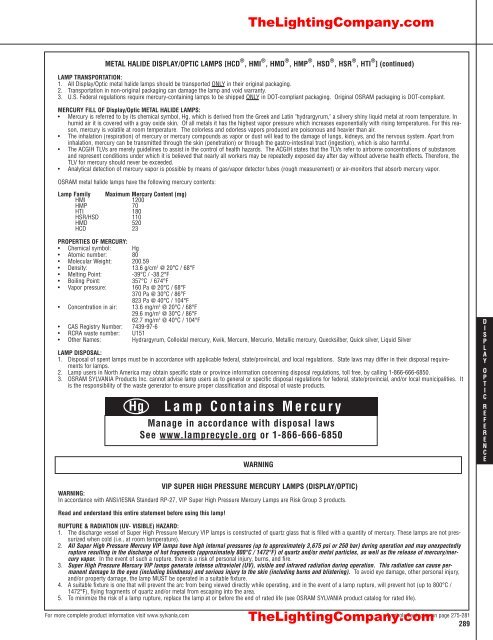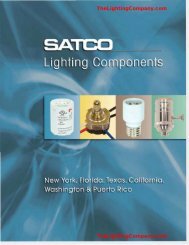Lamp and Ballast Catalog - The Lighting Company
Lamp and Ballast Catalog - The Lighting Company
Lamp and Ballast Catalog - The Lighting Company
- No tags were found...
Create successful ePaper yourself
Turn your PDF publications into a flip-book with our unique Google optimized e-Paper software.
<strong>The</strong><strong>Lighting</strong><strong>Company</strong>.com<br />
METAL HALIDE DISPLAY/OPTIC LAMPS [HCD ® , HMI ® , HMD ® , HMP ® , HSD ® , HSR ® , HTI ® ] (continued)<br />
LAMP TRANSPORTATION:<br />
1. All Display/Optic metal halide lamps should be transported ONLY in their original packaging.<br />
2. Transportation in non-original packaging can damage the lamp <strong>and</strong> void warranty.<br />
3. U.S. Federal regulations require mercury-containing lamps to be shipped ONLY in DOT-compliant packaging. Original OSRAM packaging is DOT-compliant.<br />
MERCURY FILL OF Display/Optic METAL HALIDE LAMPS:<br />
• Mercury is referred to by its chemical symbol, Hg, which is derived from the Greek <strong>and</strong> Latin "hydrargyrum," a silvery shiny liquid metal at room temperature. In<br />
humid air it is covered with a gray oxide skin. Of all metals it has the highest vapor pressure which increases exponentially with rising temperatures. For this reason,<br />
mercury is volatile at room temperature. <strong>The</strong> colorless <strong>and</strong> odorless vapors produced are poisonous <strong>and</strong> heavier than air.<br />
• <strong>The</strong> inhalation (respiration) of mercury or mercury compounds as vapor or dust will lead to the damage of lungs, kidneys, <strong>and</strong> the nervous system. Apart from<br />
inhalation, mercury can be transmitted through the skin (penetration) or through the gastro-intestinal tract (ingestion), which is also harmful.<br />
• <strong>The</strong> ACGIH TLVs are merely guidelines to assist in the control of health hazards. <strong>The</strong> ACGIH states that the TLVs refer to airborne concentrations of substances<br />
<strong>and</strong> represent conditions under which it is believed that nearly all workers may be repeatedly exposed day after day without adverse health effects. <strong>The</strong>refore, the<br />
TLV for mercury should never be exceeded.<br />
• Analytical detection of mercury vapor is possible by means of gas/vapor detector tubes (rough measurement) or air-monitors that absorb mercury vapor.<br />
OSRAM metal halide lamps have the following mercury contents:<br />
<strong>Lamp</strong> Family Maximum Mercury Content (mg)<br />
HMI 1200<br />
HMP 70<br />
HTI 180<br />
HSR/HSD 110<br />
HMD 520<br />
HCD 23<br />
PROPERTIES OF MERCURY:<br />
• Chemical symbol: Hg<br />
• Atomic number: 80<br />
• Molecular Weight: 200.59<br />
• Density: 13.6 g/cm 3 @ 20°C / 68°F<br />
• Melting Point: -39°C / -38.2°F<br />
• Boiling Point: 357°C / 674°F<br />
• Vapor pressure: 160 Pa @ 20°C / 68°F<br />
370 Pa @ 30°C / 86°F<br />
823 Pa @ 40°C / 104°F<br />
• Concentration in air: 13.6 mg/m 3 @ 20°C / 68°F<br />
29.6 mg/m 3 @ 30°C / 86°F<br />
62.7 mg/m 3 @ 40°C / 104°F<br />
• CAS Registry Number: 7439-97-6<br />
• RCRA waste number: U151<br />
• Other Names: Hydrargyrum, Colloidal mercury, Kwik, Mercure, Mercurio, Metallic mercury, Quecksilber, Quick silver, Liquid Silver<br />
D<br />
ISPLAY<br />
O<br />
PTIC<br />
R<br />
EFERENCE<br />
LAMP DISPOSAL:<br />
1. Disposal of spent lamps must be in accordance with applicable federal, state/provincial, <strong>and</strong> local regulations. State laws may differ in their disposal requirements<br />
for lamps.<br />
2. <strong>Lamp</strong> users in North America may obtain specific state or province information concerning disposal regulations, toll free, by calling 1-866-666-6850.<br />
3. OSRAM SYLVANIA Products Inc. cannot advise lamp users as to general or specific disposal regulations for federal, state/provincial, <strong>and</strong>/or local municipalities. It<br />
is the responsibility of the waste generator to ensure proper classification <strong>and</strong> disposal of waste products.<br />
Hg<br />
<strong>Lamp</strong> Contains Mercury<br />
Manage in accordance with disposal laws<br />
See www.lamprecycle.org or 1-866-666-6850<br />
WARNING<br />
VIP SUPER HIGH PRESSURE MERCURY LAMPS (DISPLAY/OPTIC)<br />
WARNING:<br />
In accordance with ANSI/IESNA St<strong>and</strong>ard RP-27, VIP Super High Pressure Mercury <strong>Lamp</strong>s are Risk Group 3 products.<br />
Read <strong>and</strong> underst<strong>and</strong> this entire statement before using this lamp!<br />
RUPTURE & RADIATION (UV- VISIBLE) HAZARD:<br />
1. <strong>The</strong> discharge vessel of Super High Pressure Mercury VIP lamps is constructed of quartz glass that is filled with a quantity of mercury. <strong>The</strong>se lamps are not pressurized<br />
when cold (i.e., at room temperature).<br />
2. All Super High Pressure Mercury VIP lamps have high internal pressures (up to approximately 3,675 psi or 250 bar) during operation <strong>and</strong> may unexpectedly<br />
rupture resulting in the discharge of hot fragments (approximately 800°C / 1472°F) of quartz <strong>and</strong>/or metal particles, as well as the release of mercury/mercury<br />
vapor. In the event of such a rupture, there is a risk of personal injury, burns, <strong>and</strong> fire.<br />
3. Super High Pressure Mercury VIP lamps generate intense ultraviolet (UV), visible <strong>and</strong> infrared radiation during operation. This radiation can cause permanent<br />
damage to the eyes (including blindness) <strong>and</strong> serious injury to the skin (including burns <strong>and</strong> blistering). To avoid eye damage, other personal injury,<br />
<strong>and</strong>/or property damage, the lamp MUST be operated in a suitable fixture.<br />
4. A suitable fixture is one that will prevent the arc from being viewed directly while operating, <strong>and</strong> in the event of a lamp rupture, will prevent hot (up to 800°C /<br />
1472°F), flying fragments of quartz <strong>and</strong>/or metal from escaping into the area.<br />
5. To minimize the risk of a lamp rupture, replace the lamp at or before the end of rated life (see OSRAM SYLVANIA product catalog for rated life).<br />
<strong>The</strong><strong>Lighting</strong><strong>Company</strong>.com<br />
For more complete product information visit www.sylvania.com Symbols/Footnotes on page 275-281<br />
289




